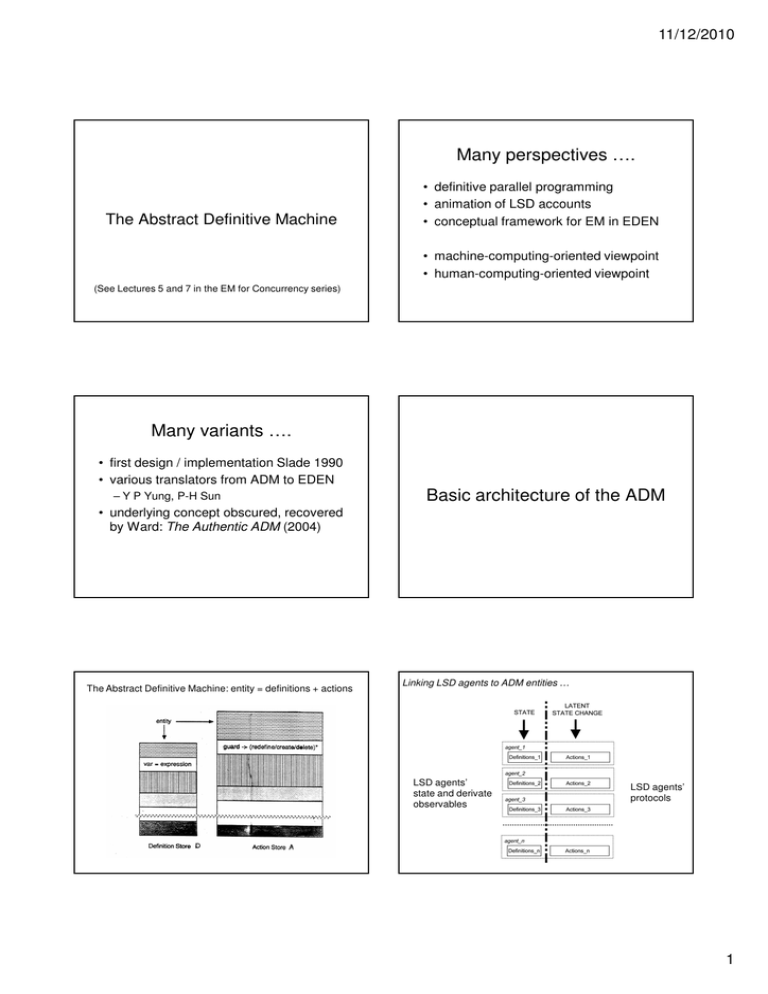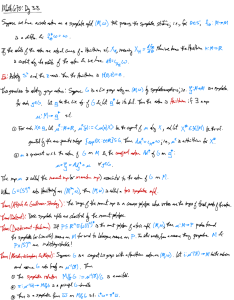Many perspectives …. The Abstract Definitive Machine 11/12/2010
advertisement

11/12/2010
Many perspectives ….
The Abstract Definitive Machine
• definitive parallel programming
• animation of LSD accounts
• conceptual framework for EM in EDEN
• machine-computing-oriented viewpoint
• human-computing-oriented viewpoint
(See Lectures 5 and 7 in the EM for Concurrency series)
Many variants ….
• first design / implementation Slade 1990
• various translators from ADM to EDEN
– Y P Yung, P-H Sun
Basic architecture of the ADM
• underlying concept obscured, recovered
by Ward: The Authentic ADM (2004)
The Abstract Definitive Machine: entity = definitions + actions
Linking LSD agents to ADM entities …
LSD agents’
state and derivate
observables
LSD agents’
protocols
1
11/12/2010
Core features of the ADM 1
• entity = set of definitions + set of actions
• have instances of abstract entities
• action is guarded sequence of form:
(redefinition + entity invocation/deletion)*
• in some contexts actions have been
interpreted as atomic; better conceived
as interleaving asynchronously
Some illustrative examples
Core features of the ADM 2
•
•
•
•
model of “true” concurrent interaction
definitions can be performed in parallel
scope for syntactic checks on interference
changes of state admit free interpretation:
– “computational step” in machine
– redesign / reprogramming step
– manual, automated and semi-automated
A systolic array simulation
Parallel programming
Model of systolic array
for sparse matrix
multiplication …
Input matrices A and B
at top-left and top-right
The Railway Station
Animation
Output matrix C = A . B
at top centre
EM paper 010: Parallel computation in definitive models
2
11/12/2010
LSD account of the stationmaster
entity sm() {
definition
whistle = false, whistled = false, sm_flag = false,
sm_raised_flag = false, can_move = false,
ready is !door_open{1} && !door_open{2}, tarrive,
Limit = 20, timeout is (Time - tarrive) > Limit,
level = 0, init = true
action
init → tarrive = Time; init = false,
door_open{1} && !around{1}
print("Station master shuts door 1")
→ door_open{1} = false,
……
}
entity sm() {
definition
whistle = false,
whistled = false,
sm_flag = false,
sm_raised_flag = false,
can_move = false,
ready is !door_open{1} && !door_open{2},
tarrive,
Limit = 20,
timeout is (Time - tarrive) > Limit,
level = 0,
init = true
action
……
}
entity sm() {
definition
….
action
init → tarrive = Time; init = false,
door_open{1} && !around{1}
print("Station master shuts door 1")
→ door_open{1} = false,
door_open{2} && !around{2}
print("Station master shuts door 2")
→ door_open{2} = false,
ready && timeout && !whistled print("Station master whistles to call guard")
→ whistle = true; whistled = true; guard(); level = 1,
level == 1 print("Station master stops whistling") → whistle = false; level = 0,
ready && whistled && !sm_raised_flag print("Station master raises his flag")
→ sm_flag = true; sm_raised_flag = true,
sm_flag && guard_raised_flag
print("Station master lowers his flag")
→ sm_flag = false,
ready && guard_raised_flag && driver_ready && engaged && !can_move
print("Train can move now") → can_move = true
}
Human and Machine
Perspectives on the ADM
The ADM from a machine perspective (Rungrattanaubol, 2002)
3
11/12/2010
Machine perspective on ADM
Machine-like execution:
• true guard as obligation to perform action
• action performed automatically / atomically
Examples
• systolic array
• railway station animation
• telephone animation
About the examples
Systolic array
• highly structured, synchronised, clocked
Railway station animation
• too regimented, clock cycle metaphor
“init tarrive = |Time|; init = false” is atomic
Telephone animation
?
• embellish actions with probabilities to reflect
delay, timeliness of response; introduces
artificial observables / actions
Human perspective on ADM
“Free agent” style execution (cf. AADM):
• true guard as entitlement to perform action
• action not atomic – intermediate states
• re-evaluation of guards during execution
Further from implementation …
execution / interpretation needs human input
… modeller takes a role in directing / acting
necessary to capture semantics of EDEN use
The ADM from the human perspective (Rungrattanaubol, 2002)
JUGS
in the
ADM
The Authentic Abstract
Definitive Machine
Ashley Ward
(after Beynon and Slade)
4
11/12/2010
Ambiguity in ADM writings
The description of the ADM in Slade refers to execution
in which sequences of commands in ADM actions are
executed atomically
This originates from the need to cope with instantiating
observables and initialising entities, or resetting
observables and deleting entities, in a single step
Execution model for the
Authentic ADM
In the application of the ADM in ‘animating LSD’, it is
appropriate to think of a guard as a cue that enables an
entity to initiate a sequence of actions to be performed
asynchronously: this is the execution model for what
Ward terms the authentic ADM …
In each step:
(The state is now S)
For each action a:
If the action a is currently executing and there is no
command from a already in the runset (pending execution)
Add the next command in action a to the runset
Else:
Evaluate guard of a in state S
If guard of a is true:
Add the first command in action a to the runset
Check the runset for an invalid transition
If the transition is invalid,
Stop and ask the modeller to resolve the conflict before
proceeding
Select a subset of the commands from the runset and execute
these, conceptually in parallel, making a transition to the state S'
(The state is now S')
In each step:
1. (The state is now S)
2. For each action a:
3. If the action a is currently executing and there is no
command from a already in the runset (pending execution)
4. Add the next command in action a to the runset
5. Else:
6. Evaluate guard of a in state S
7. If guard of a is true:
8. Add the first command in action a to the runset
9. Check the runset for an invalid transition
10. If the transition is invalid,
11. Stop and ask the modeller to resolve the conflict before
proceeding
12. Select a subset of the commands from the runset and execute
these, conceptually in parallel, making a transition to the state S'
13. (The state is now S')
Notes on selection of actions
At step 12, selection of the subset of commands can be
determined non-deterministically by the algorithm or
determined by the modeller in the ‘super-agent’ role
Due to the guarantee given by the invalid transition check,
there is no interference between actions in the runset
… in an implementation
Commands can therefore be performed sequentially or in
parallel
If commands are performed sequentially, the state will transit
intermediate states before it reaches S'. Evaluations can be
performed in these intermediate states or in S without
influencing the result as there is no interference between
commands.
5

